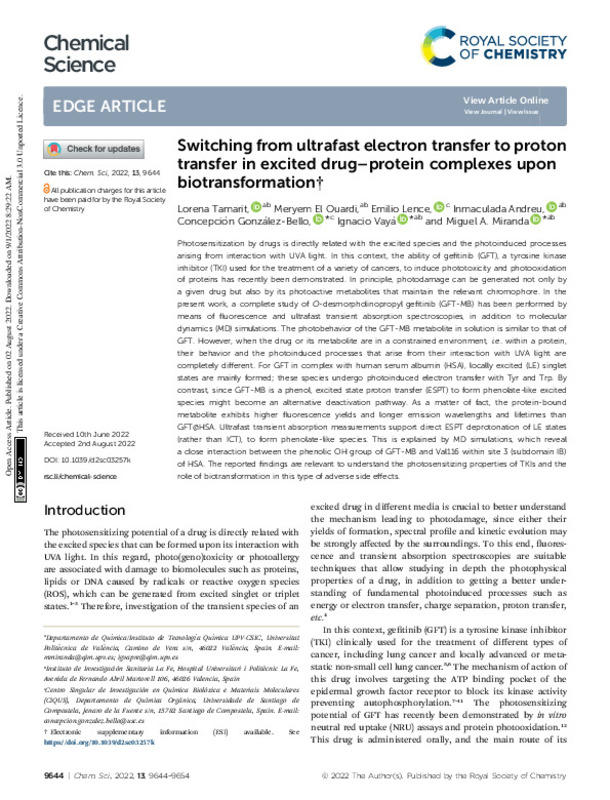JavaScript is disabled for your browser. Some features of this site may not work without it.
Buscar en RiuNet
Listar
Mi cuenta
Estadísticas
Ayuda RiuNet
Admin. UPV
Switching from ultrafast electron transfer to proton transfer in excited drug-protein complexes upon biotransformation
Mostrar el registro sencillo del ítem
Ficheros en el ítem
| dc.contributor.author | Tamarit-Mayo, Lorena
|
es_ES |
| dc.contributor.author | El Ouardi, Meryem
|
es_ES |
| dc.contributor.author | Lence, Emilio
|
es_ES |
| dc.contributor.author | Andreu, Inmaculada
|
es_ES |
| dc.contributor.author | González-Bello, Concepción
|
es_ES |
| dc.contributor.author | Vayá Pérez, Ignacio
|
es_ES |
| dc.contributor.author | Miranda Alonso, Miguel Ángel
|
es_ES |
| dc.date.accessioned | 2023-07-14T18:01:09Z | |
| dc.date.available | 2023-07-14T18:01:09Z | |
| dc.date.issued | 2022-08-24 | es_ES |
| dc.identifier.issn | 2041-6520 | es_ES |
| dc.identifier.uri | http://hdl.handle.net/10251/194993 | |
| dc.description.abstract | [EN] Photosensitization by drugs is directly related with the excited species and the photoinduced processes arising from interaction with UVA light. In this context, the ability of gefitinib (GFT), a tyrosine kinase inhibitor (TKI) used for the treatment of a variety of cancers, to induce phototoxicity and photooxidation of proteins has recently been demonstrated. In principle, photodamage can be generated not only by a given drug but also by its photoactive metabolites that maintain the relevant chromophore. In the present work, a complete study of O-desmorpholinopropyl gefitinib (GFT-MB) has been performed by means of fluorescence and ultrafast transient absorption spectroscopies, in addition to molecular dynamics (MD) simulations. The photobehavior of the GFT-MB metabolite in solution is similar to that of GFT. However, when the drug or its metabolite are in a constrained environment, i.e. within a protein, their behavior and the photoinduced processes that arise from their interaction with UVA light are completely different. For GFT in complex with human serum albumin (HSA), locally excited (LE) singlet states are mainly formed; these species undergo photoinduced electron transfer with Tyr and Trp. By contrast, since GFT-MB is a phenol, excited state proton transfer (ESPT) to form phenolate-like excited species might become an alternative deactivation pathway. As a matter of fact, the protein-bound metabolite exhibits higher fluorescence yields and longer emission wavelengths and lifetimes than GFT@HSA. Ultrafast transient absorption measurements support direct ESPT deprotonation of LE states (rather than ICT), to form phenolate-like species. This is explained by MD simulations, which reveal a close interaction between the phenolic OH group of GFT-MB and Val116 within site 3 (subdomain IB) of HSA. The reported findings are relevant to understand the photosensitizing properties of TKIs and the role of biotransformation in this type of adverse side effects. | es_ES |
| dc.description.sponsorship | Financial support from the Spanish Ministry of Science and Innovation (RYC-2015-17737, BEAGAL 18/00211, PID2020-115010RB-I00/AEI/10.13039/501100011033, FPU19/00048, PID2019-105512RB-I00/AEI/10.13039/501100011033), the Xunta de Galicia (ED431C 2021/29), the Centro singular de investigacion de Galicia accreditation 2019-2022 (ED431G 2019/03), and the European Regional Development Fund (ERDF) is gratefully acknowledged. All authors are grateful to the Centro de Supercomputacion de Galicia (CESGA) for use of the Finis Terrae computer. | es_ES |
| dc.language | Inglés | es_ES |
| dc.publisher | The Royal Society of Chemistry | es_ES |
| dc.relation.ispartof | Chemical Science | es_ES |
| dc.rights | Reconocimiento - No comercial (by-nc) | es_ES |
| dc.subject.classification | QUIMICA ORGANICA | es_ES |
| dc.title | Switching from ultrafast electron transfer to proton transfer in excited drug-protein complexes upon biotransformation | es_ES |
| dc.type | Artículo | es_ES |
| dc.identifier.doi | 10.1039/d2sc03257k | es_ES |
| dc.relation.projectID | info:eu-repo/grantAgreement/Xunta de Galicia//ED431C 2021%2F29/ | es_ES |
| dc.relation.projectID | info:eu-repo/grantAgreement/AEI/Plan Estatal de Investigación Científica y Técnica y de Innovación 2017-2020/PID2019-105512RB-I00/ES/COMBATIENDO LAS BACTERIAS RESISTENTES A LOS ANTIBIOTICOS Y CONTROLANDO SU EVOLUCION IN VIVO MEDIANTE ESTRATEGIAS INNOVADORAS Y NUEVOS TESTS DE DIAGNOSTICO CLINICO/ | es_ES |
| dc.relation.projectID | info:eu-repo/grantAgreement/AEI/Plan Estatal de Investigación Científica y Técnica y de Innovación 2017-2020/PID2020-115010RB-I00/ES/FOTOCOMPORTAMIENTO DE LOS INHIBIDORES DE LA TIROSINA QUINASA: DE DISOLUCION A CELULAS/ | es_ES |
| dc.relation.projectID | info:eu-repo/grantAgreement/Xunta de Galicia//ED431G 2019%2F03/ | es_ES |
| dc.relation.projectID | info:eu-repo/grantAgreement/MINECO//RYC-2015-17737/ES/RYC-2015-17737/ | es_ES |
| dc.relation.projectID | info:eu-repo/grantAgreement/MCIU//BEAGAL18%2F00211/ | es_ES |
| dc.relation.projectID | info:eu-repo/grantAgreement/MICINN//FPU19%2F00048/ | es_ES |
| dc.rights.accessRights | Abierto | es_ES |
| dc.contributor.affiliation | Universitat Politècnica de València. Escuela Técnica Superior de Ingenieros Industriales - Escola Tècnica Superior d'Enginyers Industrials | es_ES |
| dc.contributor.affiliation | Universitat Politècnica de València. Departamento de Química - Departament de Química | es_ES |
| dc.description.bibliographicCitation | Tamarit-Mayo, L.; El Ouardi, M.; Lence, E.; Andreu, I.; González-Bello, C.; Vayá Pérez, I.; Miranda Alonso, MÁ. (2022). Switching from ultrafast electron transfer to proton transfer in excited drug-protein complexes upon biotransformation. Chemical Science. 13(33):9644-9654. https://doi.org/10.1039/d2sc03257k | es_ES |
| dc.description.accrualMethod | S | es_ES |
| dc.relation.publisherversion | https://doi.org/10.1039/d2sc03257k | es_ES |
| dc.description.upvformatpinicio | 9644 | es_ES |
| dc.description.upvformatpfin | 9654 | es_ES |
| dc.type.version | info:eu-repo/semantics/publishedVersion | es_ES |
| dc.description.volume | 13 | es_ES |
| dc.description.issue | 33 | es_ES |
| dc.identifier.pmid | 36091919 | es_ES |
| dc.identifier.pmcid | PMC9400592 | es_ES |
| dc.relation.pasarela | S\471390 | es_ES |
| dc.contributor.funder | Xunta de Galicia | es_ES |
| dc.contributor.funder | Agencia Estatal de Investigación | es_ES |
| dc.contributor.funder | European Regional Development Fund | es_ES |
| dc.contributor.funder | Ministerio de Ciencia e Innovación | es_ES |
| dc.contributor.funder | Ministerio de Economía y Competitividad | es_ES |
| dc.contributor.funder | Ministerio de Ciencia, Innovación y Universidades | es_ES |








